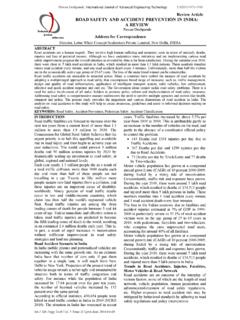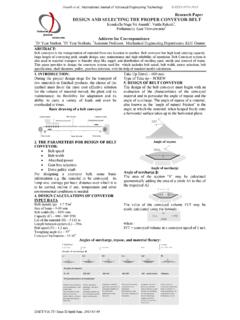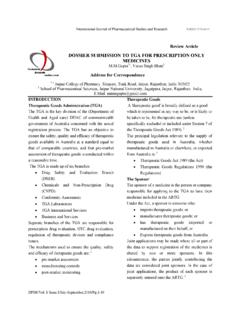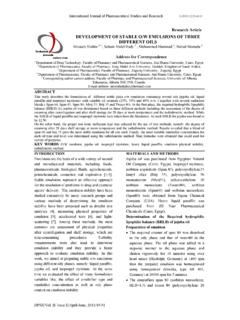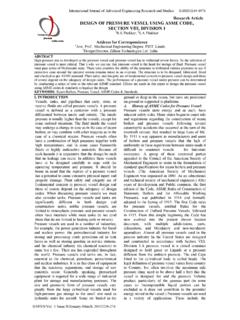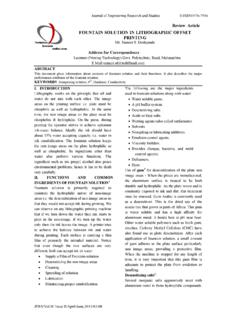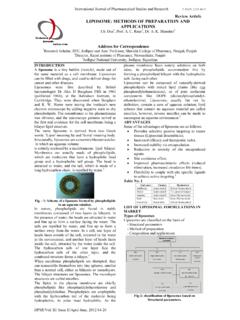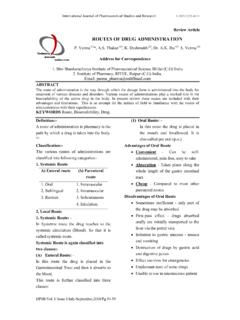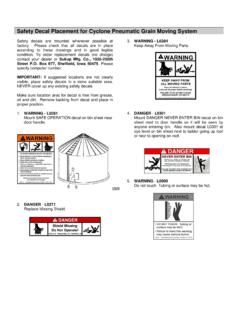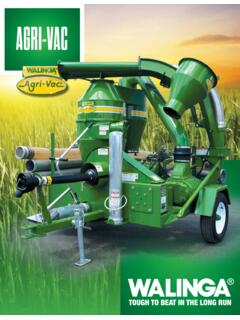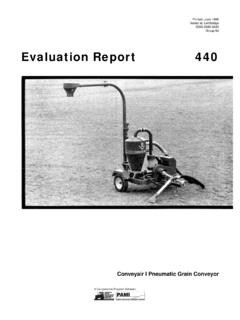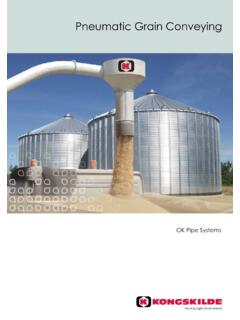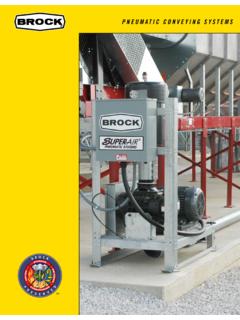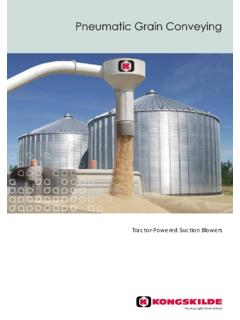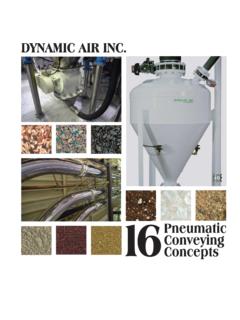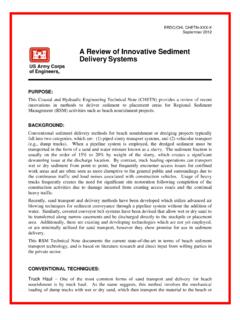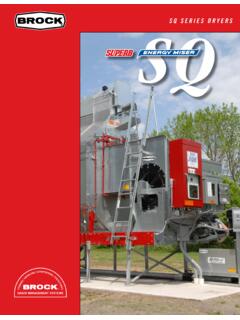Transcription of Research Paper VENTURI FEEDER SYSTEM FOR PULL PUSH …
1 Dhole, International Journal of Advanced Engineering Technology E-ISSN 0976-3945 Int J Adv Engg Tech/Vol. V/Issue III/July-Sept,2014/59-61 Research Paper VENTURI FEEDER SYSTEM FOR PULL PUSH TYPE pneumatic CONVEYING SYSTEM Dhole Address for Correspondence Government College of Engineering, Chandrapur, 442403, Maharashtra, India ABSTRACT pneumatic conveying systems are particularly versatile. A very wide range of materials can be handled and they are totally enclosed by the SYSTEM and pipeline.
2 The basic objective of the work is to develop VENTURI feeding SYSTEM for the pull push type pneumatic conveying SYSTEM , thereby creating the suction effect at the VENTURI throat. It will help to create the automatic suction of the material into the SYSTEM through the inlet provided at the throat. This SYSTEM then can be operated by the single person and has numerous practical applications for the automatic transportation of powdered and granular material. Initially five such systems were developed and tested [1], and based on the experimentation and analysis of these systems, four modified systems developed are presented here. 1. INTRODUCTION The entrainment of solid particles in a high velocity flow of air is a well known phenomenon, with examples ranging from sand storms to domestic vacuum cleaners and it is therefore not surprising that it should be the basis of an essentially simple and reliable method for the controlled conveying of bulk solids.
3 pneumatic conveying, as the method is called, may be formally defined as the transportation of dry bulk particulate or granular materials through a pipeline by a stream of gas. Whilst the gas concerned would normally be air, other gases are occasionally used, such as nitrogen in situations where there is a fire or explosion risk. pneumatic conveying systems are basically quite simple and are eminently suitable for the transport of powdered and granular materials in factory, site and plant situations [2]. A number of applications of operational principles of pneumatic transport could be seen in last decade of the 19th century at some places in Europe [2,3] and especially, in the grain transport and handling field [3].
4 We have fabricated five systems and achieved suction effect at the inlet provided at the throat. This suction effect is also capable to transfer the powdered as well as granular material through the pipe line. The attempt to create suction effect by using VENTURI effect was successful. But the output mass flow rate was low. This is because the maximum pressure used to create the suction effect was restricted to bars only. So if the higher value of blower pressure can give better mass flow rate. Dense phase pneumatic conveying SYSTEM is required to be tested which is able to give higher mass flow rate because higher solid loading ratio.
5 Nowadays, pneumatic transport is a popular technique in particulate material handling field. It has been reported that some plants have transport distance of more than 40 km [4], material flow rate of few hundreds of tons per hour and solid loading ratio (the mass flow rate ratio between solid and air ) of more than 500. Pipeline feeding devices All pneumatic conveying systems, whether they are of the positive or negative pres-sure type, conveying continuously or in a batch-wise mode, can be considered to consist of the basic elements viz. Conveying gas supply, Feeding mechanism, Conveying line and Separation equipment [5].
6 In terms of pneumatic conveying SYSTEM components, a considerable number of devices have been specifically developed to feed materials into pipelines. The material feeding device is particularly critical for the successful operation of the SYSTEM . In vacuum systems the material feeding is invariably at atmospheric pressure and so the pipeline can either be fed directly from a supply hopper or by means of suction nozzles from a storage vessel or stockpile. The main point to bear in mind, however, is that there will be no adverse pressure gradient against which the material has to be fed. The FEEDER , therefore, does not have to be designed to additionally withstand a pres-sure difference.
7 With no adverse pressure drop to feed across it also means that there will be no leakage of air across the device when feeding material into the pipeline. Separation systems in these cases, therefore, by necessity, do have to operate under vacuum conditions. In positive pressure systems, separation devices invariably operate at atmospheric pressure. Pipeline feeding in positive pressure systems represents a particular problem, however, for if the material is contained in a storage hopper at atmospheric pressure, the material has to be fed against a pressure gradient. As a consequence of this there may be a loss of conveying air.
8 The feeding device in this case has to be designed to withstand the pressure difference in addition. In certain cases this air flow can hinder the downward gravity flow of material into the FEEDER and hence interfere with the feeding process. Also, if the loss is significant, the volumetric air flow rate will have to be increased to compensate, for the correct air flow rate to the pipeline must be maintained for conveying the material. This loss, therefore, represents a loss of energy from the SYSTEM . The selection of material feeding devices primarily depends on the three factors viz. pressure drop across the pipeline, Maintenance, and Material flow properties.
9 Many diverse devices have been developed for feeding pipelines. Some are specifically appropriate to a single type of SYSTEM , such as suction nozzles for vacuum systems. Others, such as rotary valves, screws and gate valves, can be used for both vacuum and positive pressure systems. Developments have been carried out on most types of feeding device, both to increase the range of materials that can be successfully handled, and to increase the operating pressure range of the device. Each type of feeding device, therefore, can generally be used with a number of different types of conveying SYSTEM , and there are usually many alternative arrangements of the feeding device itself.
10 The basic problem with feeding positive pressure systems is that the air leakage arising from the adverse pressure gradient can interfere with the flow Dhole, International Journal of Advanced Engineering Technology E-ISSN 0976-3945 Int J Adv Engg Tech/Vol. V/Issue III/July-Sept,2014/59-61 of the material into the pipeline; this situation can be improved, to a certain extent, by using VENTURI feeders. These work on the principle of reducing the pipeline cross-sectional area in the region where the material is fed from the supply hopper. It will be seen that there are no moving parts with this type of feeding device, which has certain advantages with regard to wear problems.
